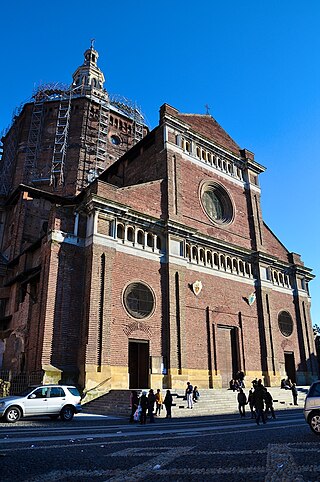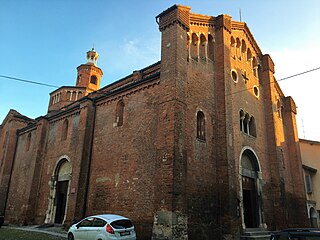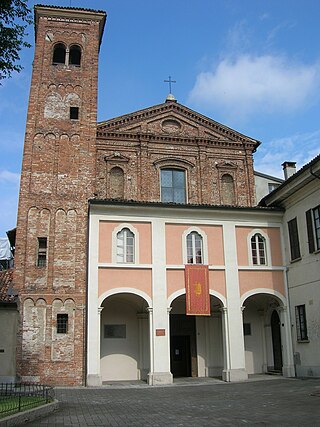Related Research Articles

Pavia is a town and comune of south-western Lombardy, in Northern Italy, 35 kilometres south of Milan on the lower Ticino near its confluence with the Po. It has a population of c. 73,086. The city was the capital of the Ostrogothic Kingdom from 540 to 553, of the Kingdom of the Lombards from 572 to 774, of the Kingdom of Italy from 774 to 1024 and seat of the Visconti court from 1365 to 1413.

Ticinum was an ancient city of Gallia Transpadana, founded on the banks of the river of the same name a little way above its confluence with the Padus (Po).

San Pietro in Vincoli is a Roman Catholic titular church and minor basilica in Rome, Italy, best known for being the home of Michelangelo's statue of Moses, part of the tomb of Pope Julius II. The Titulus S. Petri ad vincula was assigned on 20 November 2010, to Donald Wuerl. The previous Cardinal Priest of the basilica was Pío Laghi, who died on 11 January 2009.

Sep. 11 - Eastern Orthodox Church Calendar - Sep. 13

The Archdiocese of Genoa is a Latin Church ecclesiastical territory or diocese of the Catholic Church in Italy. Erected in the 3rd century, it was elevated to an archdiocese on 20 March 1133. The archdiocese of Genoa was, in 1986, united with the Diocese of Bobbio-San Colombano, forming the Archdiocese of Genoa-Bobbio; however a split in 1989 renamed it the "Archdiocese of Genoa."

February 7 - Eastern Orthodox liturgical calendar - February 9

Syrusof Pavia is traditionally said to have been the first bishop of Pavia during the 1st century.
San Teodoro or Saint Theodore of Pavia was bishop of Pavia from 743 until his death. He was repeatedly exiled by the Lombard kings. His feast day is May 20. Along with Syrus (Siro), he is a patron saint of Pavia, and his body is housed in the church with his name.

December 8 - Eastern Orthodox liturgical calendar - December 10

Romulusof Genoa was an early Bishop of Genoa, around the time of Syrus. His dates are uncertain: since Jacobus de Voragine traditional lists compiled from local liturgies generally place his bishopric fourth in a largely legendary list. He fled from Genoa and never returned He died in the cave he inhabited at Villa Matutiae, a town on the Italian Riviera which later adopted his name, becoming San Remo, and later Sanremo.

The Diocese of Pavia is a Latin diocese of the Catholic Church in Italy. It has been a suffragan of the Archdiocese of Milan only since 1817. Previous to the reorganization of the hierarchy in northern Italy by Pope Pius VII after the expulsion of the French and the Congress of Vienna, the diocese of Pavia had depended directly upon the Holy See, despite repeated failed attempts on the part of the Archbishops of Milan to claim control. The diocese has produced one Pope and Patriarch of Venice, and three cardinals.
Saint Syrus or St Syrus may refer to:

Pavia Cathedral is a church in Pavia, Italy, the largest in the city and seat of the Diocese of Pavia. The construction was begun in the 15th century on the site of two pre-existing Romanesque, "twin" cathedrals. The cathedral houses the remains of St. Sirus, first Bishop of Pavia, and a thorn purported to be from the Crown of Thorns worn by Christ. The marble facing of the exterior was never completed.
Siro may refer to:

John the Good was Archbishop of Milan from c. 641 to 669. He is honoured as a Saint in the Catholic Church and his feast day is on January 2.

San Teodoro is a Romanesque-style Roman Catholic church in the town center of Pavia, Italy.

The gens Juventia, occasionally written Jubentia, was an ancient plebeian family at Rome. After centuries of obscurity, the gens emerges into history with the appearance of Titus Juventius, a military tribune, in the beginning of the second century BC. The first of the Juventii to obtain the consulship was Marcus Juventius Thalna in 163 BC. But the family is renowned less for its statesmen than for its jurists, who flourished during the second century AD.
Syrus is a character in Greek mythology after whom Syria and the Syrians are named.

The church of San Giovanni Domnarum is one of the oldest in Pavia. In the crypt, which was rediscovered after centuries in 1914, remains of frescoes are visible.

The Church of Santi Gervasio e Protasio is a church in Pavia, in Lombardy.
References
- 1 2 Lanzoni, Francesco (1927). Le diocesi d'Italia dalle origini al principio del secolo VII (an. 604) (in Italian). Faenza: F. Lega. p. 986.
- 1 2 Watkins, Basil (2015-11-19). "Juventius of Pavia". The Book of Saints: A Comprehensive Biographical Dictionary (8th ed.). Bloomsbury Publishing. p. 411. ISBN 978-0-567-66415-0.